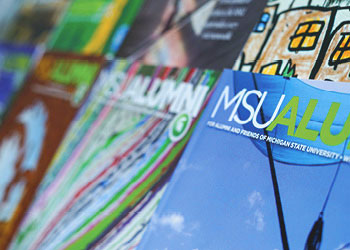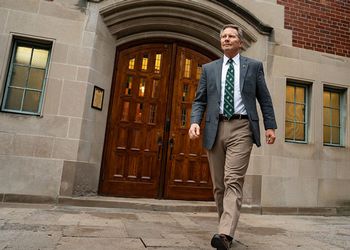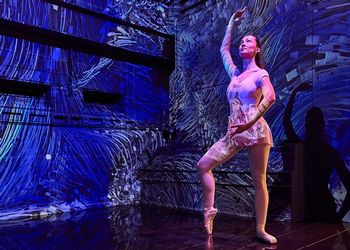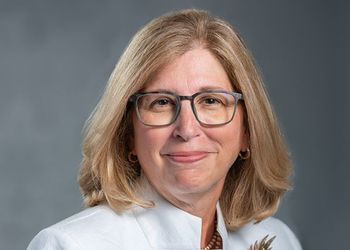Feature: MSU Athletics in the 1970s and 1980s Leadership and Change

The following excerpt is taken from the upcoming book, The Rise of a Research University and the New Millennium, 1970–2005, the third of a trilogy from the MSU Press covering MSU history from its founding to the present. Because of the current success of MSU athletics, we’ve selected from a chapter on athletics in the 1970s and 1980s. It was a tumultous era, but it also helped lay the groundwork for the present. For example, when former AD
Joe Kearney became commissioner of the Western Athletic Conference, he hired and mentored a young assistant—Mark Hollis—who would later have a dramatic impact on MSU athletics. And in 1984, basketball coach Jud Heathcote hired a young assistant by the name of Tom Izzo, who would emerge as one of the university’s—and
the nation’s—most iconic figures. –Editor.
In January 1980 Athletic Director Joe Kearney and Head Football Coach Darryl Rogers left MSU as a team of two for Arizona State University, where Rogers would coach for four years before returning to Michigan to become head coach of the Detroit Lions from 1985–88 and where Kearney would serve as athletic director for just one year before becoming commissioner of the Western Athletic Conference for fourteen years. President M. Cecil Mackey appointed Doug Weaver as athletic director, and Weaver had sole authority in choosing the next head football coach. On January 31, 1980, the Board of Trustees (BOT) unanimously approved Frank D. “Muddy” Waters on a four-year contract at an initial annual salary of $47,000. In what turned out to be three seasons, Waters’s teams compiled a record of 10-23 with half of those wins coming in 1981, when the team finished 5-6 with four Big Ten wins. When Waters was hired, Spartan fans wondered why a coach with only small-college experience (albeit highly successful) was brought into a Big Ten program. The 2-9 season in 1982 sealed Waters’s fate, although the team had in fact been competitive, losing a total of six games by seven points or less in each game. But in the end, Waters’s teams had lost to Michigan and Notre Dame all three seasons.
At its December 2–3, 1983, meeting, the BOT hired George Perles as coach on a five-year contract at a salary of $95,000 per year. The appointment was controversial because, as it turned out, it involved paying the Philadelphia Stars, a professional football team, $175,000 to buy Perles out of his contract and because of the secret nature of the negotiations. Perles was to be paid a little more than twice the incoming salary Waters had received. Many fans said “Why not earlier?” because rumors were that Perles showed interest in the job after Rogers left. Others said it was about time that a “true green” Spartan had become head coach and that the defensive prowess that the 1965–66 Spartans had featured would return, since Perles was a defensive specialist with nine years of professional coaching experience. What followed was 12 seasons for Perles at MSU before MSU President M. Peter McPherson fired him in the midst of an NCAA investigation into the athletic department.
In his first four seasons as head coach, Perles’s teams were 4-6, 6-6, 7-5, and 6-5. His record against Notre Dame was 2-2, and he was 1-3 against Michigan with only six points scored in the three losses. But the next season, as many Spartan fans remember fondly, was Perles’s 1987 season, which included a 7-0-1 Big Ten record, an opening game win against University of Southern California and the Rose Bowl rematch with the dramatic 20-17 win, and a final national UP/AP ranking of eighth with a 9-2-1 record. The 31-8 loss to Notre Dame and the 31-3 loss to Florida State on weeks two and three of the season were all but forgotten as the team went undefeated (with one tie) thereafter. It was a memorable replay of the talented 1978 Spartans, who lost their first three games and then ran off eight consecutive wins to tie Michigan for the Big Ten championship.
In basketball George M. “Jud” Heathcote’s teams compiled a 63-26 record in his first three seasons, won two conference titles (the 1978–79 one being shared with two other teams), and won the national championship in 1979. But the incredible combination of talent the 1977–78 and the 1978–79 teams featured could not be maintained, and three losing seasons followed until the 1982–83 team went 17-13. In 1985–86 the Spartans, who were 12-6 for third place in the conference, ended up 23-8 overall and went to the NCAA Sweet Sixteen. The NCAA champion Spartans in 1978–79 had lost five conference games and finished 26-6 for the season. In 1989–90 the Spartans claimed another Big Ten Championship with a 15-3 record and made the NCAA Sweet Sixteen on the way to compiling a 28-6 overall record, the most wins for a Heathcote team in a season. In his 19 seasons at MSU, Heathcote took his teams to nine NCAA tournaments. What he brought to the program was consistency, stability over almost two decades, and an ability to bounce back from losing seasons with strong teams. From 1986 through 1989 the Spartans posted a 39-50 record overall and were 17-37 in the Big Ten. But in 1989–90 the team finished first in the Big Ten and compiled a 28-6 record, losing in the NCAA regional semifinals 81-80 to Georgia Tech. Heathcote was a colorful sidelines personality with his frustrated palm slaps to the forehead—and of course, he brought on to his staff a young assistant coach, Tom Izzo, who was destined to become the most successful basketball coach in MSU’s history.
The hockey program benefitted from the opening of Munn Ice Arena on October 25, 1974, where Amo Bessone coached his final four (out of a total of twenty-seven) seasons. In the 1975–76 season the Spartans compiled their best record in the Western Collegiate Hockey Association with a 20-12-0 record and lost to Minnesota 7-6 in a triple overtime WCHA playoff, undoubtedly the most dramatic and thrilling game in the history of Munn. Bessone left a record of taking three teams to the NCAA championship game (1959, 1966 and 1967) with the 1966 team claiming a national championship by beating a 24-2 Clarkston team 6-1. The 1959 Spartans lost to North Dakota in the championship game 4-3.
Ron Mason succeeded Bessone in April 1979 and would spend 23 seasons as the head coach. When the Spartans shifted from the WCHA to the Central Collegiate Hockey Association (CCHA) in 1981, Mason’s team won the CCHA playoff championships the first four consecutive seasons from 1982 through 1985. His teams made appearances in 19 NCAA tournaments, and MSU claimed its second national title in 1986, defeating Harvard 6-5. Munn became a site of loud, enthusiastic fans in the 1980s, and tickets to games were hard to come by due to the team’s consistent success. The MSU coaching careers of Heathcote and Mason overlapped for 16 years, and both of their stays overlapped that of Perles, making this period one of the most stable in terms of the head coaches of major sports.
In women’s sports the 1970s and 1980s were a period of change and advancement. The passage of Title IX of the Educational Amendments of 1972 provided that neither men nor women could be “excluded from participation in, be denied the benefits of, or be subjected to discrimination under any educational program or activity receiving Federal financial assistance.” While the legislation did not specifically mention sports or athletics, the U.S. Department of Health, Education, and Welfare (HEW) decided that athletic programs came under the scope of the law and that colleges had to provide equal athletic opportunities for men and women. The question, of course, was what constituted “equal,” and from where funds would come to run additional women’s sports. Would this mean that certain men’s sports would be eliminated or down-graded to club status in order for women’s teams to be established? Was it reasonable to expect that gender equity in sports by the HEW target of the 1978–79 academic year? With any pioneering national legislation comes the good and the bad, those who embrace and endorse it as progress and those who oppose and are committed to obstructing it.
Title IX implementation at MSU was overseen and directed by Athletic Directors Joe Kearney (1976–80) and Doug Weaver (1979–89), and of course, involved coaches as well. The only men’s sport that was eliminated was men’s gymnastics, which had become a varsity sport in 1948 and in 1958 had shared a NCAA national team championship with Illinois. HEW regularly conducted audits of the Athletic Department to check for progress on implementation. Counterpart women’s teams were established as well as teams in sports like gymnastics, field hockey, rowing, softball, and volleyball. The athletic picture gradually became more diverse and more representative of the skills and experience that women brought to athletic endeavors and competition. To say that Title IX implementation at MSU was smooth and untroubled would be a mischaracterization since there were points of conflict (such as quality of accommodations on the road and meal allowances); however, to say that there were those committed to Title IX as the law and the terms of opportunity and equity it pointed toward would be a fair assessment. Professor Gwen Norrell, who served as the faculty athletic representative to the Big Ten Conference from 1979 through 1988 after serving in the MSU Athletic Council and who served as vice president of the NCAA from 1983 to 1985, was both a campus and national leader in integrating women’s athletics into the Big Ten and NCAA. Karen Langeland, the women’s basketball coach from 1976 to 2000, was also an important part of this process. When the NCAA began to offer national championships for women’s basketball in all divisions starting in 1982 for 64 teams, women’s programs had their own “March Madness” and “Big Dance” on which to set their sights and dreams. When the Jack Breslin Student Events Center opened in 1989, the Lady Spartans shared a basketball showcase as their home court andhad their platform on which to build ambitions.
MSU Athletics in the 1990s and Early 2000s: Modernization and Resurgence
Another major success in intercollegiate athletics had nothing to do with teams or coaches but involved facilities. Like many other aging college football stadiums, Spartan Stadium needed renovation. The support columns were showing signs of deterioration and crumbling. In February 1994 the BOT approved an initial renovation and repair project for Spartan Stadium, which took eight years to complete at a cost of $15 million. In September 2003 the Spartan Stadium Expansion project was approved at an estimated cost of $50 million. The project was seen as revenue-enhancing, with nearly 3,000 seats added, including 24 suites and a press box. A portion of the facility would house University Development, the MSU Alumni Association, the Spartan Fund and the Michigan 4-H Foundation. Off campus rent payment for University Development would end, and an Alumni Center would be established at the best possible site on campus. It was a bold step forward at a time when extreme caution seemed called for, but the plan, as presented by Athletic Director Ron Mason, showed how collaboration and coordinated planning across units could win the day. Mason, Provost Simon, Chuck Webb of University Development, Keith Williams of the Alumni Association, and finance and operations Vice President Fred L. Poston combined efforts to produce a new look for Spartan Stadium with first-rate facilities capable of generating a steady flow of additional revenues.
Other revenue-generating moves included a reseating plan for Breslin starting in the 2000–2001 season and the Spartan Stadium Scholarship Plan in May 2003. New rules guided the availability and selection of choice seats, and the fans’ willingness to pay a premium in addition to ticket cost was the guiding factor. A system of accumulated points or credits determined eligibility for various levels of seats. Fan loyalty over a long period of time and the purchase of the same seats year after year were no longer the only determining factors in seat assignment. In 1995–96 the average profits at Division 1A football schools were slightly in excess of $3 million annually with average profit increases of 7.6 percent per year. By 2011–12 MSU revenues from football were just over $45 million, and basketball generated $17 million. The decisions made to renovate and expand Spartan Stadium before the start of the 2005 season brought its capacity to 75,005.
Other new facilities included the $7.5 million Clara Bell Smith Student-Athlete Academic Center, named after Spartan basketball player Steve Smith’s mother. Smith donated $2.5 million for the facility in 1997, the largest donation to ever be given by a professional athlete to any college or university. The Jack Breslin Student Events Center underwent expansion, including an addition completed in 2002 that featured two gymnasiums, offices, and conference facilities. This addition became known as the Alfred Berkowitz Basketball Complex. Berkowitz had contributed $2 million of the $7.5 million cost of the project. The two practice gymnasiums were named after Forest Akers and George M. “Jud” Heathcote, with the Forest Akers Trust donating $1 million and the gifts and pledges made in Heathcote’s name totaling $951,000. In December 2001 a new running track and artificial turf were approved at a cost of $3.3 million for Ralph Young Field. The women’s field hockey teams now had a new well-scaled facility and escaped playing in cavernous Spartan Stadium. Off campus at Grand River Park, a new boathouse facility was built at a cost of $600,000 for MSU’s women’s rowing team. Expenditures on new sports facilities, renovations, upgrades, and additions from 1994 to 2005 totaled close to $94 million, invigorating the athletic program and extending facility modernization.
Sports other than football and basketball had a resurgence and experienced success. Leading the way was Coach Michele Madison’s field hockey team, which won the Big Ten Championship in 2001 and reached the NCAA Elite Eight; the following year the team reached the national semifinals after winning the conference tournament title. In 2003 the team shared a Big Ten Championship and won the tournament, and made another NCAA quarterfinals appearance, while 2004 brought another share of the Big Ten Championship and a second appearance in the NCAA semifinals. Madison had a remarkable run from 2001 to 2004, in which her teams compiled a 74-18 record.
The women’s golf team won a Big Ten Championship in 2001, and in 1995 Coach Chuck Erbe’s women’s volleyball team made it to the NCAA semifinals. Erbe took his teams to the NCAA tournaments in ten years between 1993 and 2004. Teams in cross country, softball, and men’s golf claimed tournament championships. Additionally, the men’s water polo club team won a national championship.
The university continued to work on a gender equity plan in order to comply with Title IX as well as the NCAA and Big Ten with the goal of balancing out the number of men’s and women’s sports and the numbers of athletes. This goal had to be reached with the scope of revenues and expenses produced by all sports. The last men’s varsity sport to be dropped was lacrosse in 1996.
Two events highlight MSU sports in this period. In October 2001 MSU played Michigan to a 3-3 tie on a rink installed on the field of Spartan Stadium. A crowd of 74,544 turned out for the “Cold War” event, which was a world record of attendees for an outdoor hockey game. The Cold War was the brainchild of Assistant Athletic Director Mark Hollis, and the game received national and international television coverage.
The second event took place on campus the weekend of February 9–10, 2002. Female athletes who had played sports at MSU but did not receive varsity letters (because the Association for Intercollegiate Athletics for Women would not allow it as was true of Michigan State’s athletic department) were invited to campus to be recognized and honored. At the women’s basketball game the returning athletes were introduced, and on Sunday at the Kellogg Hotel and Conference Center they received individual plaques with the varsity “S” letter attached. About 200 women athletes attended and, although belatedly, were recognized as Spartan athletes. The committee that recommended to Clarence Underwood the award of the varsity letters included Associate Director of Intercollegiate Athletics Shelley Appelbaum, Assistant Director for Intercollegiate Athletics Karen Langeland, Assistant Director of Intramural Sports Sally Belloli, and Assistant Sports Information Director Lori Schulze. It was one of those moments where the university’s history was adjusted and corrected for the betterment of all.
Douglas A. Noverr was a faculty member at MSU from 1970 through his retirement as Emeritus Professor in 2012. He served as chairperson of American Thought and Language, which became the Department of Writing, Rhetoric and Cultures during his 12 years as chair, and for three years as chairperson of the Department of Spanish & Portuguese. For three years he served as Senior Associate Dean in the College of Arts and Letters. His published scholarship ranges across the fields of sports history and culture, popular culture and film studies, and American literature.
HOW TO GET THE BOOK OR SERIES
Members of the MSU Alumni Association receive a 30 percent discount from the MSU Press. Here are the three volumes in the trilogy on MSU history:
Michigan State University: The Rise of a Research University and the New Millennium, 1970-2005, by Douglas A. Noverr. ($39.95, available in Spring 2015)
Michigan Agricultural College: The Evolution of a Land-Grant Philosophy 1855-1925,
by Keith R. Widder ($39.95).
Michigan State College: John Hannah and the Creation of a World
University, 1926-1969,
by David Thomas ($39.95).
To place an order, contact
the Chicago Distribution Center (800) 621-2736 (US) (773) 702-7000 (Int’l), or email orders@press.uchicago.edu
To receive the discount, please include or mention code MSUNEW when placing your order. For more information visit msupress.org.



